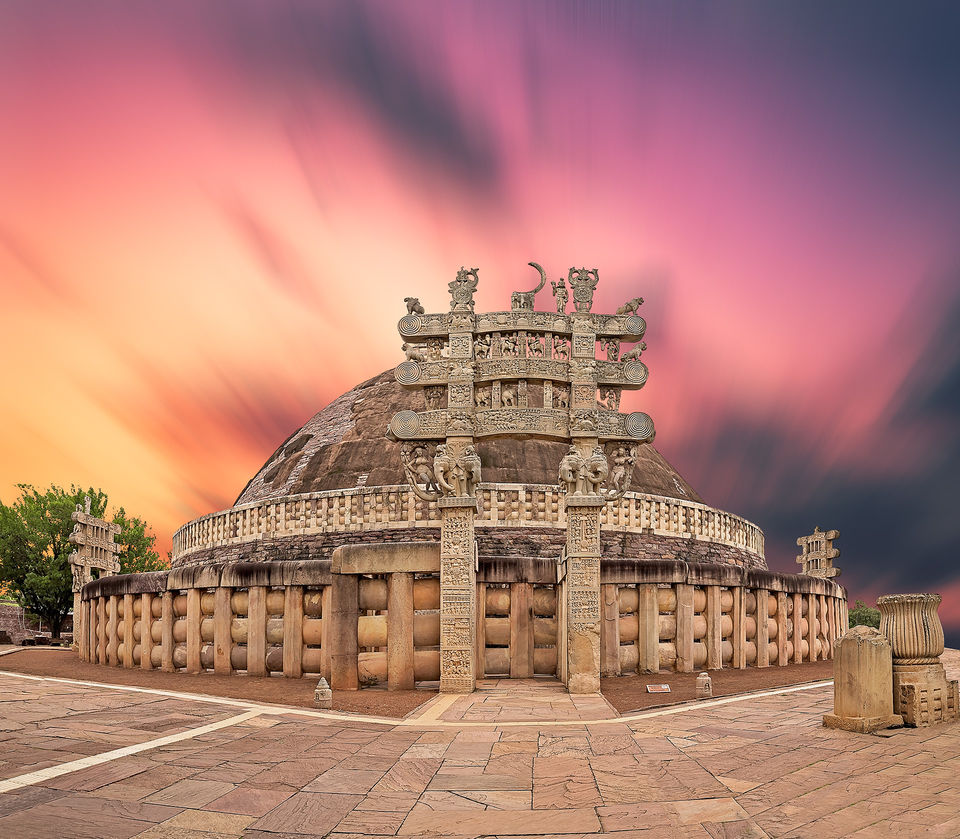

The thing that almost every traveler knows about Sanchi Stupas is that they are a UNESCO World Heritage Site. Be that as it may, it is still relatively untouched by the onslaught of maddening tourism that we now see everywhere. I reached the site on a pleasant day of July, after a car ride from Bhopal & I was thrilled to find out that there was almost no one else there visiting the site.
As is customary, there were a couple of tour guides offering their services at the entry gate & I got one Mr. Bhadauria to come along with me. It turned out to be the best guiding experience of my life & I highly recommend him to everyone visiting Sanchi.
The site was commissioned in 3rd Century BCE by emperor Ashoka of Mauryan dynasty, whose wife, "Devi" was the daughter of a merchant of nearby Vidisha. Sanchi was also her birthplace as well as the venue of her and Ashoka's wedding. Ashoka adopted Buddhism right after the battle of Kalinga (an area lying between present-day Orissa & northern Andhra Pradesh) that had left him riddled with guilt due to the massive loss of life suffered on both sides.
When Gautam Buddha attained Parinirvana, his mortal remains were enshrined & worshiped in stupas by the royals of eight kingdoms. Later on, Ashoka had these remains taken out & further divided them into 84,000 portions. He then had stupas built over them that spread out all over the region he ruled.
To be able to walk on the same pathway that was used by King Ashoka & his wife, almost two millenia ago when they entered the Sanchi complex to pay their respect, was an ethereal experience. Apart from the Great Stupa that housed Buddha's relics, there are two more smaller stupas that contained the relics of Buddha's two favorite disciples & also some of the other Buddhist teachers who had later presided over the Third Buddhist Council.

Perhaps the most striking part of Sanchi is not the stupas themselves but the four gateways surrounding the Great Stupa aka Stupa No. 1.
Historic evidence tells us that the original design of Sanchi stupas (as envisioned by Emperor Ashoka in 3rd Century BCE) was made of bricks & it was quite small in size.
It was later in 1st Century BCE that Emperor Agnimitra (son of Pushyamitra Shunga) expanded the size of the stupas & covered the original brickwork with stone.
However, the greatest addition to the design was added in the last by a Satvahana dynasty king in the form of four gateways & a boundary wall.

The dark thick coating that you see over the Great Stupa is an indigenous way of preservation. You see, in the earlier times, there was no cement or concrete, so the ancient artisans devised a paste mixture made up of eatables like urad daal, ladyfinger juice, rice, etc. that would hold things together & also help in preservation. Enough said, this concoction has stood the test of millennia & still holds strong.

The northern gateway circumventing the Great Stupa at Sanchi is the best preserved gateway out of the four. The semicircular arch you see at the top was actually a complete circle with spokes, denoting the Dharmachakra (wheel of dharma). The gateway is completely covered with sculptures depicting various episodes of the life of Buddha Shakyamuni represented in an aniconic manner (symbolic or suggestive).

It was around 12th century AD that Buddhism had seriously declined all over India, the reasons for which range from sectarian conflicts within Buddhism, loss of royal patronage, gains by competing religions such as Hinduism & Jainism & the invasions of India from Central Asia. However, it was the Muslim invasions that wiped Buddhism off & made it nearly extinct.
In such times, it was a free for all pillaging spree that was unleashed all over the Buddhist landmarks, most of which were completely destroyed while some miraculously remained unscathed with minor incidents. Sanchi was one such example which largely remained out of sight of invaders & pillagers all these centuries. It was actually much later in the 19th century when it was rediscovered by the British, that amateur archaeologists caused the maximum damage while digging & rummaging for supposed hidden treasure inside the stupas.
Much of the damaged statues, pillars segments & other relics are now stored at the Sanchi museum by Archaeological Survey of India however you will see fragmented specimens lying all around the vast expansive complex.
This statue of Buddha, for example, had its head severed which was later found buried in the ground at some distance. The head was not broken off from the body but was cut off with finesse, thereby making it a case of planned destruction rather than neglect. The statue was later restored & is now housed just along the Great Stupa.

This statue of Gautam Buddha is placed inside the peripheral boundary wall of the Great Stupa at Sanchi. The signs of vandalizing are everywhere to be seen in the complex. It could very have been destroyed during the rule of Pushyamitra Shunga, a hardcore Shiv worshipper who detested Buddhism so much that he offered rewards for anyone who brought him the heads of Buddhist monks. But see the twist of fate, his own son & successor, Agnimitra Shunga was the one who restored much of Sanchi Stupas & even added to the architecture.

This is the view from Stupa No.1, looking downhill towards the Buddhist monastery. Earlier, the top was made of timber but over the centuries, all the wood withered away and only the stone structure survived. At the lower left side is a reservoir that the monks had made to store rainwater. You can also see a beaten path towards the top right hand side of the monastery that goes further downhill towards Stupa No. 2.

A view of the Great Stupa or Stupa No. 1 & its eastern gateway
The small pillars in the foreground raised my interest & I asked around for their significance. Actually, there were several of these pillars that could be spotted all over the complex. I then came to know that in ancient times, whenever Buddhist devotees used to have any of their wishes fulfilled, they would come back & have these mini pillars constructed which signified a thankful gesture on their behalf. Several of them still have some sort of carvings but most of them have lost their outer layer & are now completely plain.



Then, there are various other structures that demand equal mention: a 4th Century AD Gupta dynasty era temple that later served as a template for all temple architecture anywhere in India, a Buddhist monastery where it is said that King Ashoka's son had studied before he was sent to Sri Lanka by his father to promote Buddhism, another Temple which is called Temple No. 45 built around the 9th Century AD & it contains an almost unscathed statue of Gautam Buddha sitting in "Bhumisparsha Mudra ".
I spent several hours covering the vast expansive area but in the end I just sat there in awe of the place & all the history surrounding it. It is truly the best site that I had visited anywhere in India.
Here are some more images for you to see:



That's it for now! Hope you liked scrolling through the photographs of Sanchi.
Tell me which one you liked the most!?
And Don't forget to follow on Instagram & Facebook for more...!
www.instagram.com/kunal88del
www.facebook.com/kunalkhuranaphotography
www.kunalkhurana.com

